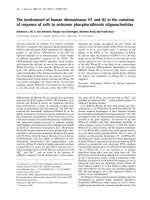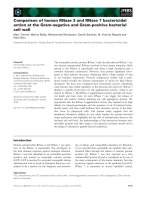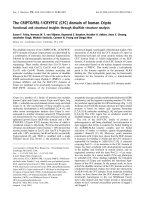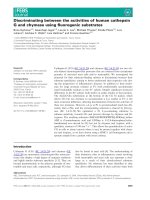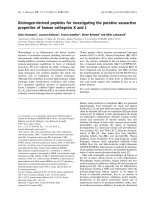LV Thạc sỹ_Evaluation of the effectiveness of human resource training and development at Deloitte vietnam
Bạn đang xem bản rút gọn của tài liệu. Xem và tải ngay bản đầy đủ của tài liệu tại đây (357.96 KB, 49 trang )
NATIONAL ECONOMICS UNIVERSITY
FACULTY OF FOREIGN LANGUAGES
ENGLISH FOR BUSINESS DEPARTMENT
EVALUATION OF THE EFFECTIVENESS OF HUMAN
RESOURCE TRAINING AND DEVELOPMENT AT
DELOITTE VIETNAM
0
NATIONAL ECONOMICS UNIVERSITY
FACULTY OF FOREIGN LANGUAGES
ENGLISH FOR BUSINESS DEPARTMENT
EVALUATION OF THE EFFECTIVENESS OF HUMAN
RESOURCE TRAINING AND DEVELOPMENT AT
DELOITTE VIETNAM
Acknowledgement
I have taken efforts in this research. However, it would not have been possible
without the kind support and help of many individuals and organizations. I would like
to extend my sincere thanks to all of them.
I am deeply grateful to my supervisor, Ms. … for her continuous instructions and
her useful advice on the report. I could never have completed and improved my writing
without her valuable comments and feedbacks.
I am also highly indebted to CMBD team and HR Department of Deloitte Vietnam
Company Limited for spending time explaining and sharing with me realistic
experience at work and precious opinions over my research topic. Especially, I would
like to express my special gratitude to Ms…, Ms. … from HR Department for providing
necessary information regarding the project.
Last but not least, an honorable mention goes to my family and friends for their
understandings and supports during my internship.
Table of Contents
Acknowledgement
Abbreviation.................................................................................................................. i
List of Figures .............................................................................................................ii
Executive Summary....................................................................................................iii
INTRODUCTION.......................................................................................................1
CHAPTER I
:
INTRODUCTION OF DELOITTE VIETNAM COMPANY
LIMITED.....................................................................................................................4
1.1 Overview of the company......................................................................................4
1.1.1 History of Deloitte Vietnam................................................................................4
1.1.2 Vision Statement and Values..............................................................................4
1.1.3 Major services.....................................................................................................5
1.1.4 Organization Chart.............................................................................................6
1.2 Key terms definition ..............................................................................................7
CHAPTER II: THEORETICAL BACKGROUND.................................................8
2.1 Overview of Human Resource Management and Human Resource Training
and Development..........................................................................................................9
2.1.1 Definition of Human Resource Management...................................................9
2.1.2 Human Resource Training and Development.................................................10
2.2 Importance of Human Resource Training and Development in business........11
2.3 Methods of Human Resource Training and Development in business.............12
2.4 Process of Human Resource Training and Development in business...............13
2.4.1 Human Resource Training process model ......................................................13
2.4.2 Kirkpatrick’s four level evaluation model ......................................................14
CHAPTER 3 : HUMAN RESOURCE TRAINING AND DEVELOPMENT AT
DELOITTE VIETNAM............................................................................................16
3.1 Current Human Resource Training and Development programs at Deloitte
Vietnam....................................................................................................................... 16
3.1.1 General Training and Development programs ..............................................16
3.1.2 Functional Training programs.........................................................................17
1
3.1.3 Policy to support employees achieve professional certificates .....................17
3.2 Process of Training courses at Deloitte Vietnam................................................18
3.3 Evaluation of Human Resource Training and Development at Deloitte Vietnam
..................................................................................................................................... 18
3.3.1 The effectiveness of Human Resource Training and Development on
employees.................................................................................................................... 19
3.3.2 The effectiveness of Human Resource Training and Development on the
company...................................................................................................................... 23
3.3.3 Some shortcomings of HR Training and Development at Deloitte Vietnam.....26
CHAPTER IV: RECOMMENDATIONS.................................................................29
4.1 Planning and responsibilities of functions..........................................................29
4.2 Time and schedules..............................................................................................29
4.3 Training evaluation..............................................................................................31
CONCLUSION..........................................................................................................32
APPENDIX
REFERENCES
1
Abbreviation
HR
Human Resources
HRM
Human Resource Management
HR T&D
Human Resource Training and Development
CEO
Chief Executive Officer
CFO
Chief Financial Officer
CPA
Certified Public Accountant
ACCA
Association of Chartered Certified Accountants
MINTA
Master of International Accounting
i
List of Figures
Figure 1: Organization Chart ....................................................................................7
Figure 2 : Advantages and disadvantages of On-the-job Training and Off-the-job
Training...................................................................................................................... 12
Figure 3 : Number of training courses employees have enrolled at Deloitte.........19
Figure 4 : Employees’ evaluation of their compatibility to the job’s requirements20
Figure 5 : Data of professional certificates at Deloitte Vietnam.............................22
Figure 6 : Employees’ evaluation of Deloitte HR Training and Development policy
..................................................................................................................................... 23
Figure 7 : Business results from 2009-2011..............................................................23
Figure 8 : Deloitte Vietnam’s turnover rates............................................................25
Figure 9 : Factors of training courses that need improvement...............................27
Figure 10 : Diagram of responsibilities and authorities..........................................29
ii
Executive Summary
Deloitte Vietnam is the first Vietnamese independent auditing company.
Together with its reputation and prestige in the financial service sector, the company
has put great effort to improve the development policy for employees. This research
presents a brief introduction of Training and Development policy of Deloitte Vietnam,
with the aim of evaluating the effectiveness of Training and Development activities of
Deloitte.
By appropriate method of analyzing figures and information collected from
questionnaires, interviews and company’s data, it can be concluded that the Human
Resources Training and Development policy at Deloitte Vietnam is quite successful.
First, thanks to the development policy, employees are very confident in their
profession, shown by their attitude toward the training courses and the superiors’
remarks over their working performance. The second benefit that employees gain from
Deloitte’s policy is the support in obtaining professional certificates which are very
useful in their long-term career. Regarding the company, Training and Development
policy affects positively to the business results over years. Because of the development
prospect at Deloitte, employees are more loyal to the company resulting in reduced
turnover rates. Finally, the opportunity to attract talents is expanded when people know
more about the Training and Development policy of Deloitte.
However, this research has found out some drawbacks of the training courses at
Deloitte including the lack of evaluation steps, the illogical time setting for training
courses and some shortcomings in the planning process. On the basis of these findings,
it is recommended that Deloitte Vietnam should focus more on the evaluation of
training results. The company needs to establish a more specific and appropriate
schedule so that all employees can take full advantage of training courses that Deloitte
offers them.
iii
INTRODUCTION
What is the most important factor in a business/organization? Human Resource
(HR) may be the answer of most business leaders. As the world is changing
continuously, there always been the need for a standardized labor force, which will
keep up with changes, and be able to bring success to the business. Accordingly, a
company which manages the HR well will have better chance to reach its goal. Among
a variety of contents of HR Management, Training and Development is one of the most
important. HR Training and Development not only helps to improve the quality of
employees, so that they can contribute significantly to the company, but also
considered as a motivation because it satisfies the self-actualization need of people (
Maslow, 1943). Today, a good HR Training and Development policy is as important as
a high salary in attracting talents to a company.
[[
Rationales
During my internship at Deloitte Vietnam Company Limited, a financial service
company, I was most impressed by its comprehensive HR Training and Development
policy. Each year, a large number of fresh graduates from well-known universities
compete to be recruited by Deloitte. Thanks to the support of the company, many
employees achieve certificates during their career and become professional in their
fields, making Deloitte a trustworthy consulting firm. That aroused the question: To
what extend do Training and Development contribute to the development of a
company?
The research titled “Evaluation of the effectiveness of Human Resource
Training and Development at Deloitte Vietnam” with useful sources of information
would possibly draw valuable lessons and contribute to the development of HR
activities of Vietnam enterprises, especially in the financial sector.
Research objectives
This research has four main purposes. The first one is to summarize the theory
related to HR Training and Development. Secondly, I want to provide information
1
about the Training and Development policy and implementation of training courses at
Deloitte Vietnam. An important aim of the research is to evaluate the effectiveness of
Deloitte’s HR Training and Development. Last but not least, this paper will identify
some shortcomings and propose recommendations to improve the quality of Deloitte’s
HR Training and Development.
Research questions
Three research questions have been developed and will serve as conceptual
framework of this study:
What are the major Human Resource Training and Development programs at
Deloitte Vietnam and how are they implemented?
How effective are the Human Resource Training and Development programs?
How can Human Resource Training and Development programs be improved?
Methodology
Primary and secondary sources are used as methods of data collection.
Firstly, a survey will be conducted among 50 Deloitte Vietnam employees in
Hanoi Office to collect primary data. The survey will include both open-ended and
closed questions, which encourage respondents to answer correctly, easily and
completely. The questionnaire is designed to collect employees’ opinions about the
training policy of Deloitte and the specific programs they have attended. In addition,
in – depth questions are also used in interviewing 10 employees at managerial level
and above. The interviews are particularly helpful for gathering opinions from the
management level about the Training and Development policy at Deloitte. Secondly,
secondary data is the information collected from sources like books, previous reports,
web pages and other printed articles…Besides, with the permission from the HR
manager , data can be collected including Training policy, Training evaluation form,
Turnover rate, Training results, Financial Statements, rate of employees having
obtained Professional Certificates during their career at Deloitte, etc….).
Furthermore, I also extract conclusions from information I have withdrawn via
2
informal talks with some employees during coffee and lunch time and observation
during my on-going internship as well.
Scope of research
The research takes place within HR Training and Development program and the
related activities in Deloitte Vietnam Company Limited ’s Hanoi Office. Data will be
collected in the period 2009 – 2011
3
CHAPTER 1: INTRODUCTION OF DELOITTE VIETNAM COMPANY
LIMITED
1.1 Overview of the company
1.1.1 History of Deloitte Vietnam
The Vietnamese independent audit history commenced in 1991 when the first
audit company, Vietnam Auditing Company (VACO) - the precursor of Deloitte
Vietnam was established on May 13, 1991. The 20-year journey of Deloitte Vietnam
thus matches the 20-year history of Vietnamese independent audit.
In 1992, VACO joined hands with Deloitte Touche Tohmatsu International
(DTT), to focus on expanding levels of international expertise and technical training
for Vietnam. This cooperation was later followed by an important turning point in
Deloitte Vietnam’s development through establishment in 1995 of an audit joint
venture company called VACO Deloitte. This joint venture company initiated the
integration of the company and signaled a new direction for the Vietnamese
independent audit sector.
Two years later, VACO Deloitte once again changed its operating form and
became an official member of Deloitte. This change transformed a local audit company
into a member and representative of an international auditing and consulting firm.
After becoming an official member of the world’s leading audit and consulting
firm, Deloitte Vietnam has continuously recorded the highest rate of growth amongst
audit companies in Vietnam.
After 20 years of continual development and success, Deloitte Vietnam now
commences another journey where there are opportunities as well as challenges ahead.
The company will focus even greater effort to achieve more success in the future and
provide clients with the best value added auditing and consulting services. A key part
of this approach is linked to the "AS ONE" strategy -“One Deloitte” that Deloitte
Vietnam is pursuing with other Deloitte member firms worldwide.
1.1.2 Vision Statement and Values
4
Deloitte’s vision is to be the Standard of Excellent and the first choice of the
most sought-after clients and talent. This vision is expressed fully by the core
values/principles that are used to unify Deloitte people. Those core values are :
Integrity; Outstanding value to markets and clients; Commitment to each other and
Strength from cultural diversity
1.1.3 Major services
Deloitte Vietnam with over 600 staff located in both Hanoi and Ho Chi Minh City
offices delivers value –added services in Enterprise Risk Services, Consulting,
Financial Advisory, Tax and Audit to the private and public sectors across a wide range
of industries. The services provided to clients can be classified as:
Enterprise Risk Services – ERS
ERS practice offers a comprehensive array of services designed to help clients
understand business risks, determine acceptable levels of exposure, provide
measurement of the risk environment and compliance levels. ERS include: Internal
Audit; Data Quality and Integrity; General Computer Controls Assessment;
Controls Assurance; Enterprise Risk Strategy and Analytics; Co-sourcing; Revenue
Assurance; Operational Risk Management.
Consulting Services
Deloitte Vietnam offers consulting services mainly in the following fields: Strategy
and Operations; Finance Transformation; Technology; Human Capital and As One.
Financial Advisory Services
Deloitte offers a comprehensive range of multi-disciplinary advisory capabilities to
clients, including corporate finance, transaction support, valuation, finance raising,
tax structuring and planning, and corporate restructuring. The sector focus (there
are 8 industry specializations e.g Energy&Resources, Financial Services, Real
Estate, Manufacturing, Public Sector, Technology&Media…) brings industry
5
expertise to clients, in any part of the whole range of business sectors, as well as the
Government.
Tax Services
The Tax practice comprises specialists having an in-depth knowledge of tax rules
and regulations, as well as of the market environment, assisting clients to optimize
their tax burden. The Tax Services include : Tax Advisory and Planning;
International Tax Structuring; Corporate Income Tax Services; Transfer Pricing; Tax
Compliance Health-Check Services and Customs and Indirect Tax.
Audit Services
This is the most famous service of Deloitte. Each year, Deloitte provides auditing
service for approximately 300 listed companies in Vietnam as well as state – owned
corporations and groups (figures from Clients and Markets Function) in which the
most remarkable clients are PetroVietnam (PVN), Vietnam Electricity Group
(EVN), Vietnam Airlines… The Audit Services include : Statutory and International
Standard Audits; Financial Statement Transformations; Financial Reporting; IFRS
Conversion Services; Review of Accounting Systems and Internal Controls and
Accounting Advisory Services.
1.1.4 Organization Chart
The total number of employees is 612, in which, 348 employees in Hanoi Office
and 264 employees in Ho Chi Minh City Office (both in the client functions and nonclient functions). There are currently 424 employees in the Audit Function, 94
employees in ERS Function, 18 employees in Financial Advisory Function, 25 in Tax
Function. The remaining 51 employees belong to other functions, i.e. the supporting
functions (see Appendix 1- Headcount of Deloitte Vietnam).
6
Figure 1: Organization Chart
Management
Board
Non-client
work
Client work
Audit Function
Tax Function
ERS Function
FAS Function
Human
Resource
Audit 1(Hanoi
Office)
Training &
Development
Audit 2(Hanoi
Office)
Finance &
Accounting
Audit 3(Hanoi
Office)
Admin
Audit 1(Ho Chi
Minh Office)
IT
Audit 2(Ho Chi
Minh Office)
CMBD
( Source : HR Department, Deloitte Vietnam)
1.2 Key terms definition
Big 4: the four largest international professional services networks in accountancy and
professional services, including PricewaterhouseCoopers (PwC); Deloitte Touche
Tohmatsu (Deloitte); Ernst&Young (E&Y) and KPMG
Partner: The highest professional level in an auditing company
Functional Leader: Leader of a function at Deloitte, e.g. Audit Leader, Tax Leader,
Learning Leader…
7
Learning Secretary: The HR employee in charge of keeping record of all learning
activities
Counseling: name of the program used as an on-the-job training method at Deloitte
Technical Training: the process of teaching employees how to more accurately and
thoroughly perform the technical components of their jobs
“As One”: Deloitte’s Global Strategy
CEO: Chief Executive Officer
CFO: Chief Financial Officer
8
CHAPTER 2: THEORETICAL BACKGROUND
2.1 Overview of Human Resource Management and Human Resource Training
and Development
2.1.1 Definition of Human Resource Management
Human Resources (HR) is all the mental and physical abilities which are used in
the process of production and business. It is also considered as the labor power of
people –which is one of the most valuable resources among different resources of
production in a company. HR consists of all employees working for a company. Today,
HR plays a vital role in the organization’s strategic planning process. As companies
reorganize to gain competitive edge, HR can help companies deal with a fast-changing
competitive environment and the greater demand for quality employees.
There are many definitions of Human Resource Management (HRM) originated
from a variety of viewpoints of scholars and experts. This paper will only mention
three definitions, which can be seen as the most appropriate ones for the research.
First, HRM consists of all the activities in an organization to attract, develop, use,
evaluate and maintain an appropriate labor force for the demands, both in quality and
quantity, of an organization (Nguyen Van Diem & Nguyen Ngoc Quan, 2007). According
to this definition, HRM is a vital part of Business Management, which will leads to the
success or failure of a business.
In another definition, HRM is a core competency of organizations (Mathis,R.L. &
Jackson,J.H., 2011). A core competency is a unique capability that creates high value
and differentiates an organization from its competitors. HRM is designing management
systems to ensure that human talent is well used to accomplish organizational goals.
Whether employees are in big company with thousands of jobs or a small non profit
agency, managing people in an organization is about more than simply administering a
pay program, designing training, or avoiding lawsuits.
9
Lastly, K.Aswathappa (2005) cited three other definitions and concluded by
giving his opinion: “HRM refers to a set of programs, functions and activities designed
and carried out in order to maximize both employee as well as organizational
effectiveness.”
In order to reach the organization’s goals, HRM must perform certain functions.
Although the contents of functions of HRM differ from one organization to another,
this research found out that the following functions are fundamental ones: 1.human
resource planning, 2.employee relations 3. recruitment and selection 4. training and
development 5. appraisal and assessment 8. salary and compensation.
2.1.2 Human Resource Training and Development
“In most organizations, both large and small, there is little pressure from top
management to prove that the benefits of training outweigh the cost. Many managers
at high levels are too busy worrying about profits, return on investment, stock prices,
and other matters of concern to the board of directors, stockholders, and customers.
They pay little or no attention to training unless they hear bad things about it.”
(KirkPatrick,D.L & KirkPatrick,J.D, 2006)
What is the purpose of training and development in a company? No one can be
sure that he/she will definitely keep up with all the tasks given in a new job or new
company no matter how brilliant he/she is. Furthermore, the continuously change of all
requirements in a position to adapt well with international development is another
challenge. That is why we need Training and Development.
“Training is the learning activity that helps employees to complete their roles more
effectively by improving their knowledge and skills.
Development activities bring employees skills and ability so that they can work in
another duty/position suitable with the development strategy of an organization.”
( Nguyen Van Diem & Nguyen Ngoc Quan, 2007)
HR Training and Development are processes that attempt to provide an employee
with information, skills, and an understanding of the organization and its goals.
Development and training activities are designed to help a person continue to make
10
positive contributions under the form of good performance. HR Training and
Development are top priorities for many companies, leading to the success of business.
2.2 Importance of Human Resource Training and Development in business
Regarding the roles of HR Training and Development (HR T&D) , Dr. Nguyen
Ngoc Quan stated three reasons making this activity necessary in businesses.
“First, HR T&D helps employees meet the job requirements, in other words, meet the
demand of existence and development of an organization. Second, HR T&D satisfies
the need of learning further of employees. Last, HR T&D is the strategic solution to
create competitive advantages of businesses.” ( Nguyen Van Diem & Nguyen Ngoc
Quan, 2007).
However, the above conclusions are too general. The specific roles of HR T&D
can be classified into 2 categories: the benefits of T&D for employees and the benefits
of T&D for organizations. ( />HR T&D creates greater job satisfaction and morale among employees.
Employees take more satisfaction in a job when they know how to do it well. If they
are not sure how to do, they will be frustrated and dissatisfy with their work. Besides,
the combination of job satisfaction and peer acceptance leads to improvement of selfesteem. Training activities also help employees to enhance their skills leading to higher
working performance. Employees who demonstrate excellent performance at one level
in an organization often have the opportunity to get promotion. Another benefit for
employees that can easily recognize is the increase of employee motivation. If
employees receive a good policy to develop their career, they will contribute more to
the organization.
In addition, HR T&D also brings many benefits to the organization. Employees
who are well trained will be more productive than the ones who learnt by mistakes and
trials, and the result is increased productivity for the company. Besides, a standardized
training system will result in higher levels of customer satisfaction: employees are able
to take care of customer properly and have better skills to solve customers-related
problems Improvement of quality: standards are met when people know what the
organizations expect from them. Moreover, after being trained and have mastered the
background knowledge, employees will be able to create realistic and applicable ideas,
thus increase the innovation in strategies and products of the company. Another
11
important thing is the reduction of employees’ turnover rates, because people tend to be
more loyal with the organization which supports their development. Last but not least,
HR T&D makes the enhancement of company’s image and competitiveness, comparing
to other rivals.
2.3 Methods of Human Resource Training and Development in business
Training methods are categorized into 2 groups: On-the-job training and Off- thejob training (Nguyen Van Diem & Nguyen Ngoc Quan, 2007) On the job training:
refers to methods that are applied in the workplace, in which the employees are
actually working. Off the job training occurs when employees are taken away from
their place of work to be trained.
Figure 2: Advantages and disadvantages of On-the-job training and Off-the-job
aining
tr
Advantages
-
-
-
On-the-job training
Tailor-made course content
with use of real company
situations/examples
Less expensive than off –
job training
Learning will take place
using the equipment which
will be actually used
Trainees acclimatize more
rapidly
-
-
Disadvantages -
-
Possibility of poor
instruction and insufficient
time
Trainee may be exposed to
bad work practice
A large amount of spoiled
-
Off-the-job training
A specialist instructor
enables delivery of high
quality training
Wider range of facilities
and equipment are available
The trainee can learn the
job in planned stages
It is free from the pressures
and distractions of company
life
Easier to calculate the cost
Can result in transfer of
learning difficulties
Can be more expensive
12
Methods
work and scrap material
may be produced
- Valuable equipment
may be damaged
- Orientation training
- Job-instruction training
- Apprentice training
- Internship and
assistantships
- Job rotation
- Coaching
-
-
Day release (employee
takes time off work to
attend a local college or
training centre)
Distance learning / evening
classes
Block release courses
Sandwich courses
Sponsored courses in higher
education
Self-study, computer-based
training
(Source: Nguyen Van Diem & Nguyen Ngoc Quan, 2007)
2.4 Process of Human Resource Training and Development in business
2.4.1 Human Resource Training process model
The process of HR Training& Development was described clearly in a diagram
(Harris, D.M. & DeSimone, R.L., 2002)(Appendix 2) . It includes 4 major works:
training needs assessment, training design, training implementation and training
evaluation. First, training needs assessment analyzes the organization’ needs; the
knowledge, skill, and ability needed to perform the job; and the employees’ needs.
Second, training design is a process that requires a blend of instructional learning
principles and media selection. After assessing training needs, it is necessary to design
courses for training such as setting up training objectives, methods, materials and
contents. Training implementation involves location, time and other logistic
arrangement for training informed to staff timely. The teachers prepare not only
training contents/ material but also other related knowledge/ suitable method/ skills.
The subjects of training also are identified suitable to the content of training. Training
13
conduction is carried out right after every preparation steps are ready. Last but not
least, training evaluation is an essential process. There are three reasons for training
evaluation : To justify the existence and budget of the training department by showing
how it contributes to the organization’s objectives and goals; to decide whether to
continue or discontinue training programs and to gain information on how to improve
future training programs.
2.4.2 Kirkpatrick’s four level evaluation model
KirkPatrick,D.L has developed a model of training evaluation ( KirkPatrick,D.L.
& KirkPatrick,J.D., 2006). It is currently the most widely used evaluation approach. It
is simple, flexible and complete using a four level approach.
Level 1: Reaction/ Satisfaction (Did they like it?)
-
-
-
Evaluate: Are people happy with the training inputs?
Measures how participants in a program react to the training
Evaluation tools: 'Happy sheets', feedback forms, verbal reaction, post-training
surveys or questionnaires.
Level 2: Learning (Did they learn?)
Evaluate: What do people remember from the training session?
Learning has taken place when one or more of the following occurs: Knowledge
is increased; Skill is improved; Attitudes are changed
Evaluation tools: Typically assessments or tests before and after the training.
Level 3: Behavior / Transfer of Learning (Did they use it?)
Evaluate: Do people use what they know at work?
Evaluation methods: Observation and interview over time are required to assess
change, relevance of change, and sustainability of change.
Level 4: Work Results (Did it impact the bottom line?)
Evaluate: What are the outcomes of applications on the job over a period of
time?
Results evaluation is the effect on the business or environment by the trainee.
14
-
Evaluation methods: Can include increased production, improved quality,
decreased costs, reduced frequency or severity of accidents, increased sales,
reduced turnover and higher profits, quality ratings, achievement of standards
and accreditations, growth, retention, etc.
In addition, Jack J. Phillips (1970s) of the ROI Institute, Inc. developed a Level 5
ROI evaluation, as a follow on to the Kirkpatrick Levels 1 – 4 Evaluation Model for
the measurement of training programs. Phillips’ Level 5 takes the measurement of the
effectiveness of training program to a higher level – converting the benefits of the
training to a monetary value, thereby demonstrating its value to the bottom line. The
Phillips ROI Methodology™ encompasses four major phases: 1.Evaluation Planning;
2. Data Collection; 3.Data Analysis; 4.Reporting
During phase 3, we convert our data to a monetary value, using the ROI formula:
ROI = Net Program Benefits / Program Costs x 100
15


